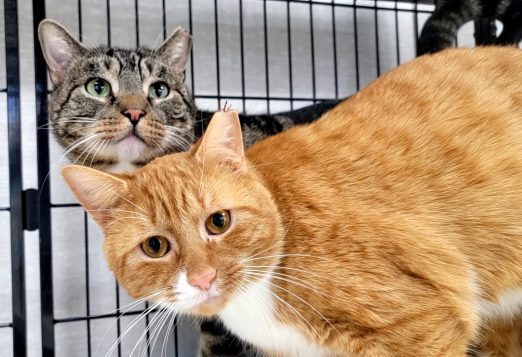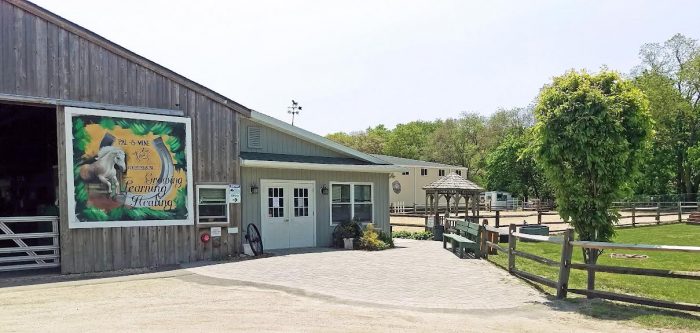By Daniel Dunaief
Nature plays a slow game, drawn out over millions of years, of hide and seek. First, spectacular and elaborate creatures lived hunted, reproduced, and avoided predators millions of years ago. After they died in places like Dorset in the United Kingdom, their bodies became preserved in the muddy, shallow marine environment. The sediment was then covered over by rock layers and safely preserved.

Fast forward about 185 million years, after waves crashing upon the shore erode those rocks on a beach and expose those fossils.
Indeed, in 2017, in a UNESCO World Heritage site where scientists and fossil hunters and paleontologists like 19th century star Mary Anning made key discoveries, archeology enthusiasts Paul Turner and Lizzie Hingley found the head, backbone and limbs of a creature scientists had imagined, but hadn’t, until then, discovered.
Called a thalattosuchian, which is an ancient sister of modern day crocodile ancestors, this finding extended the timeline of when these coastal marine crocodiles lived.
In late 2019, Dr. Roger Benson, who was then at the University of Oxford, reached out to Pedro Godoy, a postdoctoral researcher at Stony Brook who Benson co-supervised during his PhD, and Eric Wilberg, Assistant Professor at the Department of Anatomical Sciences at Stony Brook University. The team, which included Alan Turner, Professor in the Department of Anatomical Sciences at the Renaissance School of Medicine at Stony Brook, planned to describe and characterize the fossil.
Benson said he had never met Wilberg before but had “read his work on croc evolution and really admired his systematic approach.”
This ancient crocodilian creature, which was about six feet long and was likely either a sub adult or an adult, is the first “thalattosuchian fossil complete enough to definitively identify as a member of the group of rocks older than about 180 million years ago,” Wilberg explained.
Wilberg, Godoy (who is now a postdoctoral researcher at the University of Sao Paolo), Turner and Benson (who is currently Macaulay Curator of Dinosaur Paleobiology at the American Museum of Natural History), recently published their study on this fossil in the Journal of Vertebrate Paleontology.
Godoy said that Wilberg is “an expert in this group of animals and it was great working with him on this.” Godoy added that this was an “important finding, which helps us fill a gap in the evolution of thalattosuchians.”
Benson suggested that this fossil provides a glimpse into the origin of thalattosuchians, indicating that the group originated before this fossil. The particular organism is the first discovered in a new species gathered by the two fossil hunters (see related story on right).
The Thalattosuchian group lived until the Early Cretaceous period, about 130 million years ago. These predators likely fed on fish or cephalopods like ancient octopi or squid.
Recently, another team of scientists discovered a thalattosuchian skull in Morocco, which is about five to 10 million years older than the Turnersuchus Wilberg described.
The discoveries “support our prediction that thalattosuchians evolved millions of years earlier —probably in the late Triassic” around 200 million or more years ago, Wilberg added. His analysis determined that the thalattosuchian lineage diverged from its last common ancestor with crocodile-relatives during the Triassic period.
Wilberg and other researchers will be on the lookout for additional specimens which can add details to the understanding of this species. This specimen was missing most of the front of the skull, all of the hindlimb and pelvis and most of the tail.
Specific features
By examining the spinal column and part of the forelimb, Wilberg explained that this species did not have forelimbs that evolved into flippers, like later descendants in the group. It would have been similar in overall body form to living crocodiles, which means that it likely had similar swimming capabilities.
The specimen included a couple of partial teeth. Like all living crocodiles, it likely continually replaced its teeth throughout its life. Its bite force would have been less than a similar sized modern crocodile. The modern crocodylian skull evolved structural reinforcements to allow it to withstand the massive bite forces it generated.
Thalattosuchians skulls were “not as well reinforced, so they were probably not able to bite as hard,” Wilberg wrote. It seems likely that the “muscles that generate fast bites were large in this group, so they may have evolved for fast bites to capture small-moving prey.”
The Turnersuchus probably lived close to the coast in relatively shallow water. Like living crocodiles, it also likely spent time out of the water to bask in the sun (it was also cold blooded) and lay eggs. The climate of the region when this species lived would have been warmer than the current climate of the United Kingdom.
This creature was likely not an apex predator, with larger hunters like ichthyosaurs, pleiosaurs and probably sharks likely preying on it.
“We don’t have any direct evidence of predation from these groups on thalattosuchians, but it probably happened,” Wilberg added.
This particular fossil, like many other discoveries, has numerous unknowns. The gender of the individual (which scientists often determine by comparing body sizes) is unclear.
This particular find will “continue to be important moving forward in determining how thalattosuchians are related to other fossil crocodiles — every new species discovered is a chance to test existing hypotheses of how they are related to one another” which is important in determining how evolution occurred in the group, Wilberg explained.
—————————————–
The fossil hunters who lent their names to an ancient crocodile
By Daniel Dunaief
The beaches along the southern shore of the United Kingdom have rich and ancient stories to share.
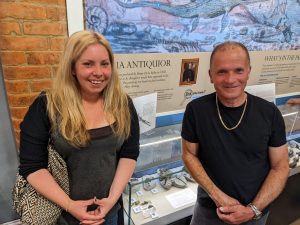
Lizzie Hingley and Paul Turner — friends who met on the beach and started working together in 2016 — are eager to gather clues about the past. Fossil hunters at the UNESCO World Heritage Site in Charmouth in the United Kingdom, which is about a three-hour drive southwest from London, Hingley and Turner discovered fragments of an unusual fossil starting in 2017. “Initially, we just saw random bones,” explained Hingley, who finds, prepares and sells some of the fossils on her website. Some fragments appeared to be a jaw in the clay next to an initial stone block containing multiple bones.
Hingley, who lives a ten minute walk from a beach that is also referred to as the Jurassic Coast, said that it’s “very unusual to come across anything with lots of bones in it on the beaches.” She took the find to her workshop, where she used an air abrasive and pneumatic chisel. She noticed it was semi-articulated, which means the bones were arranged in something resembling a natural order.
It took about one and a half years for Hingley and Turner to collect all the pieces of this fossil. Turner found the first main block, Hingley discovered the jaw next to it, Turner uncovered the next two and she found the last piece.
“It was quite difficult to collect as it was coming out of a huge glacial landscape,” said Hingley. It likely fell out of the cliff 50 years earlier and had been traveling to the front of the slip over the years. “This meant that, although we did try to dig for it, the best way to recover it was to wait for nature to uncover it for us,” she added.
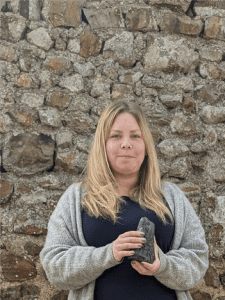
Hingley and Turner visited daily to make sure they didn’t miss any pieces. The Charmouth Heritage Centre staff found a few loose vertebrae and reunited them with the rest of the fossil.
Hingley, who is one of about 15 people who regularly search parts of the seven miles of beaches almost daily, wanted to do more than collect this fossil — she wanted to know its history. Through her network, she found Roger Benson, who was a Professor of Paleobiology at the University of Oxford.
“It was great to work with him and see the scans being done,” she said. “He was instrumental” in bringing together a team of researchers who could analyze the finding and put it into historical context.
Indeed, Benson reached out to several researchers at Stony Brook University, including his former postdoctoral researcher Pedro Godoy, Assistant Professor Eric Wilberg and Professor Alan Turner (see related story on left) to gather information.
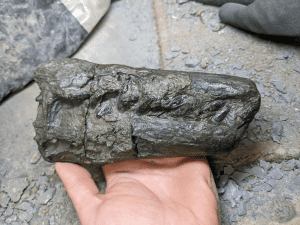
Their work concluded that this was a new species of marine crocodile. The ancient crocodile relative was named Turnersuchus hingleyae, after the fossil hunters who discovered it.
“It’s wonderful to have my name go down in history,” said Hingley, who also has a gastropod named after her.
Hingley, who is 35, started looking for fossils when she was six in Dorset, first on family holidays and then at every opportunity she could get. Over the years, she has found ichthyosaur skulls, ammonites measuring half a meter across, shark skin and teeth and numerous blocks containing hundreds of ammonites. When she was eight, she found a 20 centimeter ichthyosaur jaw, which is still part of her own collection.
Hingley is thrilled with her job, in which “every day is different and you never know what you are going to find or be working on,” she wrote. “I get to spend a lot of time in nature on the beach; the tide changes the beach every day, too.”
Benson described the beaches where Hingley and Turner search for new fossils as a European “pilgrimage for paleontologists.”
Hingley added that the process of erosion, which reveals fossils hidden in the cliffs along the beach, is something of a double edged sword, revealing fossils and threatening to carry them away.
A storm can decimate a beach and destroy fossils when the tide is too high to collect examples of creatures that lived as many as 185 million years ago. At the same time, erosion along the coast, caused by some of these same storms, reveals new fossils.
Walking along the beach, Hingley explained that it is almost incomprehensible to imagine the time scale separating her from the creatures who died so long ago.
The environment on the Jurassic Coast didn’t change much over those millennia.
“It is odd to think that you are collecting from the sea bed when it’s coming out of the cliff many meters above you,” she wrote. “The distance and time that these fossils have travelled to be found is incredible.”

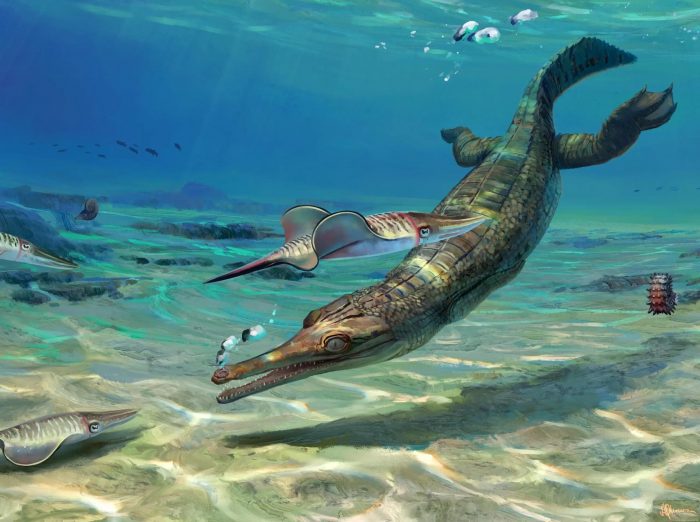




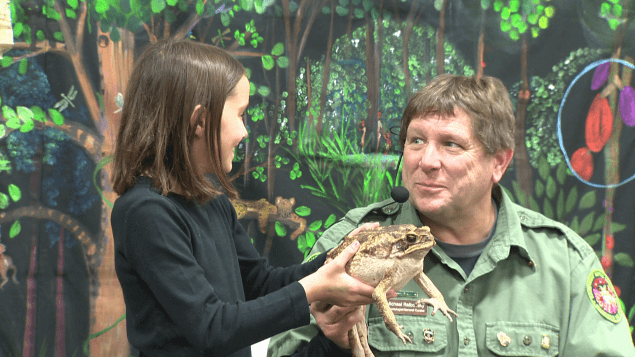

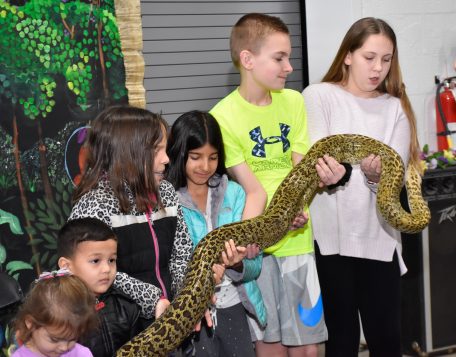

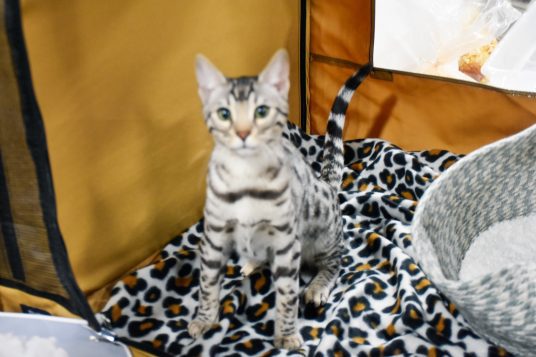
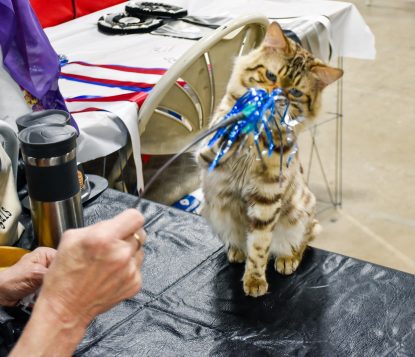


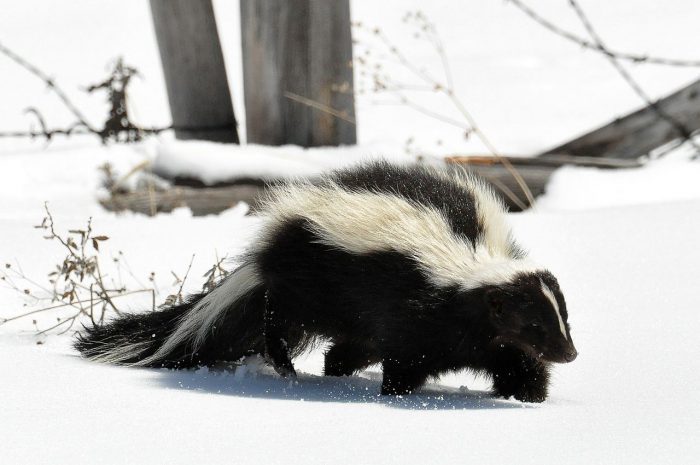

 A resident of Setauket, John Turner is conservation chair of the Four Harbors Audubon Society, author of “Exploring the Other Island: A Seasonal Nature Guide to Long Island” and president of Alula Birding & Natural History Tours.
A resident of Setauket, John Turner is conservation chair of the Four Harbors Audubon Society, author of “Exploring the Other Island: A Seasonal Nature Guide to Long Island” and president of Alula Birding & Natural History Tours.





